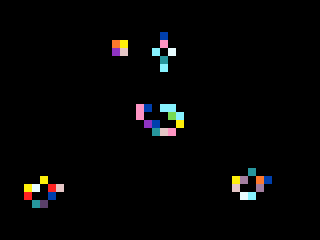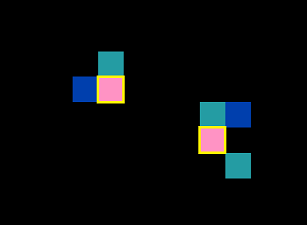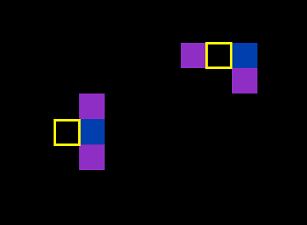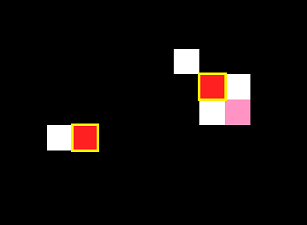We saw in the previous tutorial that three rules were needed to build a simulation of (intelligent?) life which features self-replication, communication and motion, and chaotic, unpredictable patterns.
These rules all basically require looking at each cell and counting the number of live neighbors of that cell.
Let's begin by writing code which counts live neighbors!
There is a function in your workspace that takes the column and row of a cell. Write code to return the number of alive neighbors for this cell. Note that each cell has 8 neighboring cells (corners count!).
Think about how to add up the neighbors of the cell you're at! Maybe this block will help:
let count = 0;
if (conways.getStateInDirection(conways.Direction, 0, 0) {
count += 1;
}
Now that we can count alive neighbors, we need to implement the three rules of Conway's Game of Life! We saw in the last tutorial that these rules are:
- Any live cell with 2 OR 3 living neighbors survives.
- Any dead cell with exactly 3 living neighbors becomes alive.
- All other live cells die, and all other dead cells stay dead.
We've made a function for each of these rules. Look at the
||conways:on generation update [x] [y]|| block to see where they are being
called!
In the ||functions:ruleOne|| function, add code to
ensure that any currently alive cell with 2 or 3 living
neighbors survives to the next generation. Make sure to use
the ||variables:neighbors|| variable!
The two pink cells above will survive to the next generation.
function ruleOne(col: number, row: number, neighbors: number) {
if (conways.getState(col, row)) {
if (neighbors == 2) {
conways.setState(col, row, true);
} else if (neighbors == 3) {
conways.setState(col, row, true);
}
}
}
Next, add the ||functions:ruleTwo|| code so that any
currently dead cell with exactly three living neighbors
becomes alive.
The two dead cells highlighted in yellow will become alive in the next generation.
This code will be very similar to the code you wrote for rule one! Check out this block as well:
if (conways.getIsDead(0, 0)) { }
Finally, add the ||functions:ruleThree|| code so that any
currently alive cell with less than two or greater than
three living neighbors dies.
The two red cells will die in the next generation.
-
:gamepad: Congratulations, you've coded the game of life! 🕹 Check it out in the simulator tab. 🕹
-
:mouse pointer: Click on the
||conways: set initial state||block and draw some shapes. When you're ready to move on, click the Done button to go to the challenge activity.
let count = 0;
let north = conways.Direction.North;
if (conways.getState(0, 0) || conways.getIsDead(0, 0)) {
if (conways.getStateInDirection(conways.Direction, 0, 0)
|| conways.getIsDeadInDirection(conways.Direction, 0, 0)
&& count < 3) {
count = count + 1;
conways.setState(0, 0, false);
}
}
let directions = [];
conways.setInitialState(img`
........................................
......................1.................
........................1...............
.....................11..111............
........................................
........................................
........................................
........................................
........................................
........................................
.............1..........................
.......11...............................
........1...111.........................
........................................
........................................
........................................
........................................
........................................
........................................
........................................
........................................
........................................
........................................
.........11.............................
........11..............................
.........1..............................
...................................11...
..................................11....
...................................1....
........................................
`)
function countAliveNeighbors(column: number, row: number) {
return 0;
}
function ruleOne(column: number, row: number, neighbors: number) {
}
function ruleTwo(column: number, row: number, neighbors: number) {
}
function ruleThree(column: number, row: number, neighbors: number) {
}
conways.onGenerationUpdate(function(col: number, row: number) {
let aliveNeighbors = countAliveNeighbors(col, row);
ruleOne(col, row, aliveNeighbors);
ruleTwo(col, row, aliveNeighbors);
ruleThree(col, row, aliveNeighbors);
})
let paused = false;
game.onUpdateInterval(100, function () {
if (!(paused)) {
conways.nextGeneration()
}
})
controller.B.onEvent(ControllerButtonEvent.Pressed, function () {
conways.nextGeneration()
})
controller.A.onEvent(ControllerButtonEvent.Pressed, function () {
paused = !(paused)
})
arcade-conways=github:jwunderl/arcade-conways#v0.0.4



